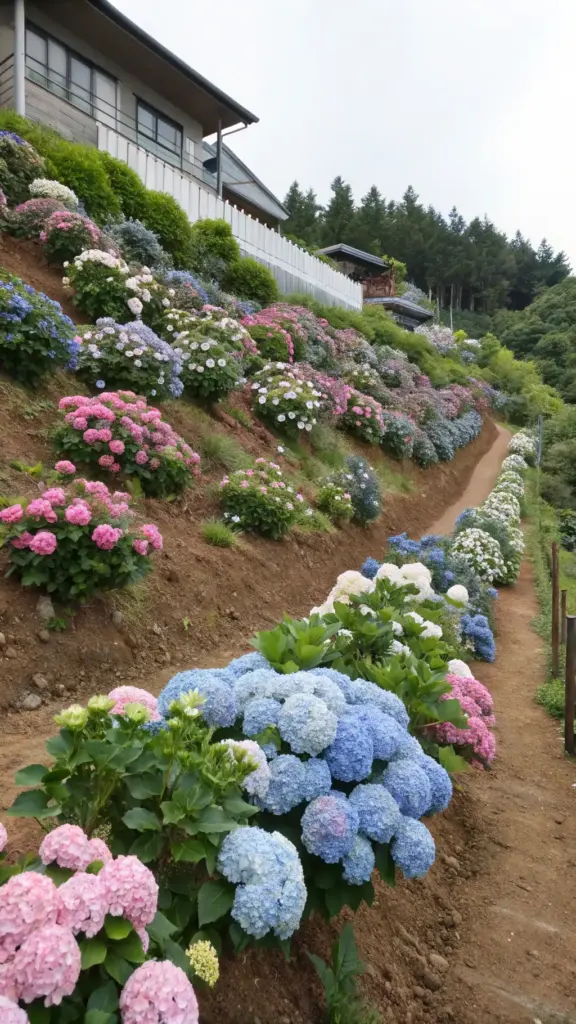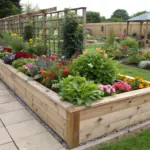6. Hydrangea Haven: Creating a Colorful Hillside Retreat

There’s something magical about hydrangeas. Their big, bold blooms can transform any space into a lush, vibrant haven. But planting them on a hill? That takes a bit of know-how. I’ll never forget the first time I tried growing hydrangeas on a slope—I didn’t prep the soil properly, and let’s just say it wasn’t pretty. Over time, though, I’ve learned how to create a hydrangea haven that thrives even on tricky terrain. Let me share my tips so you can avoid the same mistakes I made.
Preparing Soil for Hydrangeas on Slopes
Here’s the thing about hydrangeas: they’re picky about their soil. If you want those iconic blue blooms, you’ll need acidic soil. For pink blooms, go alkaline. And if you’re aiming for white hydrangeas, well, they don’t care as much—they’ll bloom beautifully regardless.
When I first started, I didn’t test my soil, and I ended up with muddy purples instead of the vibrant blues I was dreaming of. Lesson learned: always test your soil’s pH before planting. You can adjust acidity by adding aluminum sulfate for blue blooms or lime for pink ones. On slopes, it’s especially important to mix these amendments thoroughly because water runoff can wash them away if you’re not careful.
Pro tip: Work compost into the soil to improve drainage and give your hydrangeas a nutrient boost. Hillsides can dry out quickly, so rich, well-draining soil is a must.
Using Hydrangeas to Create Bold Color Blocks
One of my favorite things about hydrangeas is how they can be used to create bold color blocks that make a hillside pop. Imagine a sea of pink hydrangeas flowing into a patch of blues, with white blooms sprinkled in like clouds—it’s like painting with flowers!
To achieve this, group hydrangeas of the same color together in clusters. I once tried mixing colors randomly, thinking it would look whimsical, but it just ended up looking messy. Stick to clear sections of color for maximum impact. For example, plant ‘Nikko Blue’ hydrangeas at the top of the hill for a cool, calming effect, then transition to ‘Limelight’ whites in the middle, and finish with ‘Pink Diamond’ at the bottom for a warm, inviting vibe.
And here’s a fun fact: the color of your hydrangeas can change slightly depending on the season and soil conditions. It’s like having a living, breathing piece of art!
Mulching Techniques to Retain Moisture
Hillsides can be tricky when it comes to keeping plants hydrated. That’s where mulch comes in. Mulching isn’t just about aesthetics—it’s essential for retaining moisture and preventing erosion.
I use a thick layer (about 2-3 inches) of organic mulch, like shredded bark or pine straw, around the base of my hydrangeas. Not only does it help the soil stay damp, but it also breaks down over time, adding nutrients back into the ground. On slopes, I create little “mulch dams” by piling extra mulch around the uphill side of each plant to slow water runoff.
Pro tip: Avoid volcano mulching—piling mulch too high against the stems can lead to rot. Keep it a few inches away from the base to let the plant breathe.
Seasonal Care Tips to Extend Blooms Through Fall
If you want your hydrangeas to keep blooming well into fall, a little TLC goes a long way. First, deadhead spent blooms regularly. It’s like giving your plants a haircut—it encourages new growth and keeps them looking fresh.
In late summer, switch to a fertilizer with less nitrogen and more phosphorus to promote blooming instead of leafy growth. I also water deeply once a week during dry spells, making sure the soil stays moist but not soggy. Overwatering is just as bad as underwatering, so check the soil before you grab the hose.
Here’s a trick I swear by: in early fall, prune lightly to remove any damaged or overcrowded stems. This helps airflow and gives your hydrangeas a fighting chance to bloom a second time before winter sets in.
Alright, ready to explore the zen-like beauty of Japanese-inspired gardens? Click the next button below to learn how to incorporate cherry blossoms, moss, and water features into your hillside design. Spoiler: it’s all about balance and tranquility—and it’s easier than you think!









GIPHY App Key not set. Please check settings